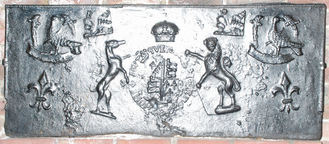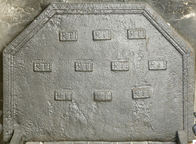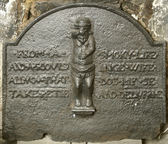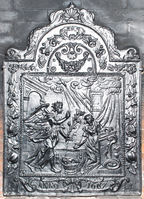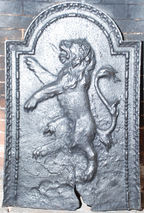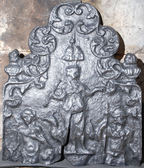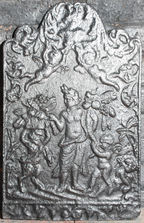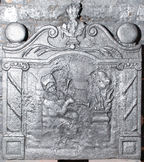-
10
Description: Rectangular; rope edging (top and sides); central Tudor royal shield with encircling garter (motto reversed: HONE SOVT QVEY … PEN), separate greyhound and lion supporters, separate crown; a bird, repeated in each top corner, its wings displayed and inverted and its head facing behind and to the left, standing on a scroll; a fleur de lys repeated in the bottom corners; inside the birds is a repeated stamp, half of one similar to a stamp on a fireback in Hastings Museum.
Notes: The particular form of the Tudor arms and supporters is encountered on other firebacks, as are the distinctive style of fleurs de lys and the birds (probably swans, a Lancastrian icon). The plain scroll upon which the bird is perched suggests that there might have been a painted inscription on it originally and that the stamp had not been made specifically for the decoration of firebacks but was, perhaps, redundant from interior domestic decoration. Formerly at Framfield, East Sussex.
Arms: Tudor royal (prob. Henry VIII)
- Decoration tags:
- rectangular (shape)
- rope (edging)
- carved stamps
- heraldic
- armorial
- royal
- objects
Manufactured: in the early- to mid-16th century possibly at Pounsley Furnace, Framfield in the Weald area of England.
Current location: The Clergy House, Alfriston, East Sussex, England.
Museum number: 200044 (part of the National Trust museum group)
-
876
Description: Canted rectangle; complex moulded edging (top and sides); rectangular incised initial stamp repeated ten times 3-4-3.
Notes: The use of an incised stamp is uncommon.
Inscription: RTI [repeated 10 times]
- Decoration tags:
- rectangular with canted top corners (shape)
- complex individual (edging)
- carved stamps
- text
Manufactured: in the 17th century in England.
Current location: Westwood Manor, Bradford-on-Avon, Wiltshire, England.
Museum number: 222509.1 (part of the National Trust museum group)
- Attached to series:
- Initials only firebacks
- Miscellaneous stamp firebacks
-
875
Description: Canted rectangle; double fillet edging (top and sides); repeated 'X' stamp parallel to edging, horizontally across centre, and in two parallel lines from top to centre, dividing top half of plate into three sections; 'daisy' stamp approximately in middle of top left and right sections, repeated four times in triad in top middle section, and thrice along top of bottom section; small roundel stamp repeated 3-3-1 in top left section, and 3-1-3-1 in top right section; date split between top left and right sections; initials split in top centre section.
Notes: An arrangement with several elements likely to have been repeated on other firebacks.
Inscription: 16 D[reversed] B 81
- Decoration tags:
- rectangular with canted top corners (shape)
- double fillet (edging)
- carved stamps
- heraldic
- text
- objects
Manufactured: in 1681 in the Forest of Dean area of England.
Current location: Westwood Manor, Bradford-on-Avon, Wiltshire, England.
Museum number: 222490 (part of the National Trust museum group)
- Attached to series:
- Date & initials firebacks
- Newent area group
- Miscellaneous stamp firebacks
-
993
Description: Arched rectangular shaped; ovolo-moulded edging (top and sides); central stamp of a carved bracket figure of a bearded man in a loincloth and cap; rhyme in capitals across rectangular plate, letters carved on strips, split by figure.
Notes: The twin miseries of a smoky house and a scolding wife are mentioned several times in literature. The dress of the figure suggests work as a miner, possibly linking this back with the Forest of Dean. Variants with initials and dates are also known.
Inscription: FROM ·A·-·SMOKY ·LIFE·/ AND·A SCOVL DING·WIFE·/ALL MEN THAT-DOE·ME·SE/ TAKE·PETIE- AND·DELIVER ME
- Decoration tags:
- rectangular with round arch (shape)
- ovolo (edging)
- carved stamps
- text
- humans
Manufactured: in the mid-17th century possibly at Tintern Furnace in the Forest of Dean area of Wales.
Current location: Westwood Manor, Bradford-on-Avon, Wiltshire, England.
Museum number: 222507 (part of the National Trust museum group)
Citation: Chambers, L. H., 26 Sep 1912, 'Fireback: Relic of 1660', Notes and Queries, 11th series, 6, p. 230.
- Attached to series:
- Twin miseries series
- Figurine firebacks
-
21
Description: Rectangular central panel with bead edging all round, pictorial representation of the Annunciation by the Angel Gabriel to the Virgin Mary, the angel carries a lily, Mary kneels at a desk, between them is a basket, above them a dove descends from clouds amid sunbeams, to the left is an arch, in the centre a bed, and to the right a window and a canopy; above the panel is a bead-edged arch with a central scallop shell and a floral swag suspended from scrolls; arched rectangular shaped border with fillet edging, a cascade of leaves and fruit (inc. apples, grapes, pears and pomegranates) descending from a wreath, at the base two cartouches conjoined by a scallop shell and containing the inscription; on top a scallop shell between two dolphins.
Notes: A common fireback design originating in the Siegerland of north Germany and made for the Dutch market. A good clear casting. The illustration is copied from Virgil Solis, 'Biblische Figuren',1562.
Copies of this fireback are known.
Inscription: ANNO 1667
Manufactured: in 1667 in the Siegerland area of Germany.
Current location: Bateman's, Burwash, East Sussex, England.
Museum number: 761056 (part of the National Trust museum group)
Citation: Herskamp, W, 2007, Die Eiserne Bibel (Helios, Aachen).
- Attached to series:
- 'Dutch' Miscellaneous Firebacks
- New Testament firebacks
-
24
Description: Arched rectangular shaped with fillet and cavetto dentil moulding, and paternost bead edging inside; a lion rampant
Notes: Whole pattern. An unusually tall fireback in relation to its width.
Copies of this fireback are known.
- Decoration tags:
- rectangular with round arch (shape)
- cavetto dentil (edging)
- whole carved pattern
- heraldic
- animals
Manufactured: in the 18th century in England.
Current location: Bateman's, Burwash, East Sussex, England.
Museum number: 761107 (part of the National Trust museum group)
- Attached to series:
- Miscellaneous pattern firebacks
-
25
Description: Quasi-arched rectangular shape with arch decorated with floral swirls and an urn on each shoulder; three female figures: Aphrodite on the left, Hera in the centre on a plinth with two peacocks behind her, and Athena on the right; a double tassel hangs above Hera’s head.
Notes: The figures are the participants in the Judgement of Paris, the outcome of which precipitated the Trojan War.
Copies of this fireback are known.
- Decoration tags:
- rectangular with ornate arch (shape)
- fillet (edging)
- whole carved pattern
- pictorial
- mythological
- humans
Manufactured: in the early-18th century in England.
Current location: Bateman's, Burwash, East Sussex, England.
Museum number: 761070 (part of the National Trust museum group)
- Attached to series:
- Late pictorial series (all)
- Late pictorial series 4
-
26
Description: Quasi-arched rectangular shape with swirled and draped foliage across the top; fillet edging with bottom panel containing indistinct floral scrolls; figure of Plenty/Abundance holding a bunch of fruit, accompanied on her left by a cherub, and receiving a further bunch of fruit from a faun to her right; two cherubs hold foliage aloft.
Notes: The figure of Plenty is one of the representations in the Iconologia, published in the early 17th century by Cesare Ripa, and subsequently in other editions. They frequently form the subject of firebacks.
Copies of this fireback are known.
- Decoration tags:
- rectangular with round arch (shape)
- fillet (edging)
- whole carved pattern
- pictorial
- allegorical
- humans
Manufactured: in the early-18th century in England.
Current location: Bateman's, Burwash, East Sussex, England.
Museum number: 761087 (part of the National Trust museum group)
- Attached to series:
- Late pictorial series (all)
-
27
Description: Arched rectangular shape with symmetrical scrolled ‘portico’ above, a flower vase between and circular discs at each end, symmetrical horizontal palm fronds below; pilaster with spiral design and Ionic capital on each side; central pictorial scene of a bagpiper with Elizabethan ruff and soft cap with feather in front of a vaulted ruin, on the right a flaming cauldron on a plinth.
Notes: This seems to be pastiche using various elements derived from other firebacks, notably the moulding and scrolled top are from the Lenard fireback , and the palm fronds are from elsewhere. The figure may be adapted from a painting of a bagpiper by Abraham Bloemaert (1564-1651).
Copies of this fireback are known.
- Decoration tags:
- rectangular with ornate arch (shape)
- none (edging)
- whole carved pattern
- pictorial
- humans
- objects
Manufactured: in England.
Current location: Bateman's, Burwash, East Sussex, England.
Museum number: 761118 (part of the National Trust museum group)
- Attached to series:
- British 'Dutch' style firebacks
-
28
Description: Rectangular with pediment raised on inverted consoles; ovolo, egg and dart edging; shield, garter, helm, mantling, crest and motto of the English House of Stuart; date split either side of garter buckle.
Notes: One of several firebacks, all of the same date, but varying in size, framing style and moulding; all have stylistic features in common and will have been the work of the same pattern maker, who was also responsible for carving royal coats of arms in three West Country churches.
Copies of this fireback are known.
Inscription: HONY SOIT QVI MAL Y PENSE / 16 18 / DIEV ET MON DROIT
Arms: English Stuart royal (James I)
- Decoration tags:
- rectangular with detached pediment (shape)
- ovolo, egg and dart (edging)
- whole carved pattern
- armorial
- royal
- text
Manufactured: in 1618 possibly in the Forest of Dean area of England.
Current location: Bateman's, Burwash, East Sussex, England.
Museum number: 761132 (part of the National Trust museum group)
